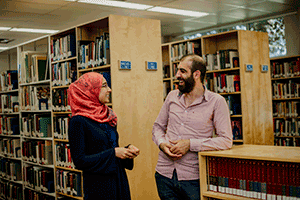Ready to learn more?
Get all the details straight to your inbox!

The Luther Library has over 24,000 items in its collection, 5,000 books checked out per year, and 7,000 students who come through its door per month.

Luther College is recognized for its high standards of teaching, focused research, and one-on-one academic advising. We value and protect this heritage of excellence in scholarship, freedom of inquiry, and faithful seeking after truth.

To enrol as a Luther College student, simply fill out the University of Regina application form and select Luther as your campus of choice.

Luther College is a great choice for high school to university transition. Enjoy all the benefits of a larger campus, without feeling lost in the crowd. Our community is full of caring mentors and peers to ensure a positive student experience.

Luther students can register in Arts, Science, or Media, Art, and Performance. Luther students are U of R students and receive a U of R degree.

Eating better means studying better. The Luther Cafeteria offers fresh, healthy, nutritious meals seven days a week with a self-serve “all-you-care-to-eat” concept students prefer.

Living in The Student Village at Luther College, our student residence, comes with a choice of healthy, nutritious meal plans. That means no grocery shopping, no meals to cook, and no dirty dishes to worry about. You can focus on your studies and wellness!

Smaller class sizes at Luther College means more individualized attention and better connections with your professors, classmates, and academic advisors.
Get all the details straight to your inbox!

By Yvonne Petry
Any list of historic events or people includes Martin Luther (1483–1546) and the beginning of the Reformation in 1517 as one of the top ten historic changes in world history. The spark that Luther struck with the Ninety-Five Theses lit a fire across Western Europe, found a receptive audience among fellow clergymen and scholars, but also knights, urban middle class, and unhappy peasants. The German Reformation began in Wittenberg, where Luther taught, but within a few years spread throughout Germany, the Netherlands, Switzerland, France, then to England and Scandinavia. Over the next forty years, entire nations broke from the authority of the Roman church and redrew the map of Europe.
Martin Luther himself recognized the impact of the events of 1517. Looking back to that year thirty years later, by which time Luther was in his sixties, he wrote that
I was a preacher, a young Doctor of Theology, as they say. I began to dissuade the people from lending an ear to the shouts of the indulgence-sellers. I told them that they had better things to do and that I was sure that in these matters I had the pope on my side. … What I did toppled heaven and consumed earth by fire.[1]
One of the big questions historians ask about the history of church reform is: why did Martin Luther succeed when others before him had failed? One of the most common answers to this question is that, by 1517, European society had begun to change in fundamental ways, but the church as an institution had not.
In order to understand what happened in 1517, it is vital to begin by examining the social history of the Christian Church prior to the Reformation. Medieval Christianity was vibrant in many ways. For the peasants, who comprised the vast majority of the population, Christianity was part of village life. They did not understand complicated doctrines concerning the Trinity or the nature of Christ. Rather, they participated in the ritual life of the church, a life that was shared communally. They called on the saints for healing or protection; they watched the priest elevate the sacred host, believing he was doing something miraculous; they went on pilgrimages to view relics; they feasted and fasted according to the church calendar; and they relied on the sacraments of the church to carry them from cradle to grave and into the next life.
Most people did not worry about their salvation – after all, they were being watched over by the saints, and they had priests, monks, and nuns were praying for their souls. They understood that after death, people went to purgatory for a final cleansing or “purging” of their sins, on the path upward to heaven. Scholastic theology – called scholastic because it came out of the medieval universities – suggested that if individuals did their best, God would recognize their efforts and help them on their way.
To understand the issue with indulgences, it is also important to know something about the sacrament of penance, which was the way in which the church promised people absolution of their sins. It involved three actions: contrition, confession, and satisfaction. Priests used books called penitentials which listed the appropriate action that would give satisfaction for any given sin. Typical acts of penance included fasting on bread and water, repeating the Ave Maria or Lord’s Prayer, giving alms, or visiting a shrine. Because acts of penance were often inconvenient, it became increasingly common to buy an indulgence rather than perform an act of penance.
Penitential practices evolved slowly over several centuries. Indulgences were first used during the crusades and promised remission of sins to those who fought in the Holy Land. Popes then began to issue them to those who made pilgrimages to Rome. By the fourteenth century, funds raised from indulgences were being used to repair and build churches. In 1343, Pope Clement VI began to speak of the treasury of merits, the concept that the church possessed surplus merits that could be purchased. In 1476, Sixtus IV said that indulgences could be used to help souls in purgatory; in other words, indulgences became transferable from one person to another.
With these developments, penitental practices also began to sound quite financial. In fact, scholastic theologians borrowed metaphors from the expanding money economy and the new science of bookkeeping. It was as though individuals had their own bank accounts with debits (sins) and credits (merits). Each sin committed depleted the account; fortunately, the Church possessed an inexhaustible reserve of surplus measured. As God’s representative on earth, the pope was the chief financial officer of the whole operation. By the late fifteenth century, increasing numbers of “pardoners” roamed around Europe, selling indulgences; we find one such individual in Chaucer’s Canterbury Tales (1476).
The penitential system was based on the assumption that sin was quantifiable, and that the Church possessed the surplus merits to allow individuals to indulge in those merits in order to receive pardon for their own or others’ sins. Whatever we may think of this system, it did possess a sort of logical coherence. And it was accepted as valid for many centuries.
In summary, by the late Middle Ages, a picture emerges of tight-knit village communities, held together by festivals, by rituals, and processions, and more or less assured that the sacraments of the Church, including the sacrament of penance, would enable them to go to heaven. However, long before the Reformation began, it was clear that there were cracks appearing in the edifice of the institutional church.
Throughout the Middle Ages, the Christian Church was not only the most important religious institution at the centre of European culture, society, and political life. Over many centuries, the Church had also become thoroughly wedded to the hierarchical class structure of Western Europe. In other words, the Church hierarchy mirrored the social hierarchy, with some bishoprics remaining in the hands of the same noble family over generations.
The office of the pope was a hugely important political position, and medieval popes repeatedly claimed authority over kings and emperors. Papal power reached its peak during the twelfth century, but then slowly began to erode. By 1309, political instability in Rome and political manoeuvering by Philip IV of France resulted in the pope leaving Rome for southern France, where his successors would remain for the next seventy years. The Avignonese popes tended to serve the interests of the French kings. Efforts to return to Rome resulted in the Great Schism in 1378 when two rival popes claimed precedence; efforts to resolve the Schism in turn led to a period where three men claimed to be pope. This institutional chaos ended only in 1417.
Beginning in the fourteenth century, there was general recognition that the Church needed reform at many levels. In fact, nearly two hundred years before Luther was born, Oxford Professor John Wycliffe (1320–1384) was outspoken in his criticism of the wealth of the church, the immorality of the clergy, and practices such as the veneration of saints. In the 1380s, he began translating the Bible into English and saw the need to make it available in the vernacular languages. The Czech scholar Jan Hus (1369–1415) translated Wycliffe’s work and ideas and introduced his program of reform in Bohemia.
At the Council of Constance of 1414–1418, one agenda item was the ending the Schism. Another item was the investigation of the ideas of Wycliffe and Hus. Both men were declared heretics by the Council: Hus was burned at the stake as a heretic, and the Council ordered that Wycliffe’s remains were to be exhumed and burned. Nevertheless, the Church would be increasingly criticized and ridiculed – and the new generation of popes just added to the problems.
By the fifteenth century, the Italian city states were embroiled in endless warfare amongst themselves, yet produced some of the most stunning art and architecture in Western history. The Renaissance popes were men of their time and waged war, plotted against their neighbours, hired Michelangelo and Raphael to decorate their homes, and began rebuilding St. Peter’s. They did not heed the growing calls for reform.
By the fifteenth century, there was a clear cultural and religious disconnect between northern Europe and Italy. Northern Europeans in the Low Countries and the German states had slowly invented their own religious practices, known as the devotia moderna or Modern Devotion. Groups such as the Beguines emerged, women who wanted to live communally without taking the restrictive vows of the nuns. Schools were founded by the Brothers of the Common Life who taught a new form of introspective Christianity that had more to do with meditating on one's sins, and less with processing around the church with a consecrated host. One of the classic works of Christian devotion, The Imitation of Christ, was written during this time.
Moreover, humanist scholars were beginning to question scholastic theology, considering it too narrow. Italian humanists had rediscovered their own Roman heritage in the works of Cicero, but Northern humanists turned their attention to studying the Bible in the original languages. As he studied the original Greek text of the New Testament, the Dutch scholar Erasmus realized that in some places the Vulgate (the Latin translation of the Bible) was inaccurate. Among other things, he noticed that in Matthew 3:2 and 4:17 the Greek term metanoeite was used. The Vulgate translated this as “do penance.” In his annotations, Erasmus (1466–1536) pointed out that a more accurate translation would be “repent.” The combination of the new humanistic learning and the desire for a more interior spirituality meant that for many people in towns and cities, the traditional rituals and practices of the Church began to feel rather hollow. During this period, there was a significant increase in anticlerical sentiment, expressed in pamphlets and satires that ridiculed the clergy for their greed, lack of morals and lack of education.
The most important development that undergirded this shifting cultural climate in Northern Europe was the invention of the printing press by Gutenberg around 1450. It ushered in a technological revolution matched only by the computer revolution of our day. For the first time in Western history, mass communication was possible. Within fifty years of the invention of movable type, print shops appeared all over Europe in towns and cities, producing books, broadsheets, pamphlets, and images.
Also for the first time in Western history, a literate middle class began to emerge; it would become the engine of the Reformation. Because reading is a solitary pursuit, that literate middle class was necessarily more individualistic, and it is obvious that by the early sixteenth century, people were beginning to worry about their salvation. For both scholars and the new literate middle class, the traditional answers that the Church provided began to sound empty and unsatisfying. The fact that many of the priests, especially those in rural areas, could not read also led to dissatisfaction.
In summary, criticism of the Church increased in the early sixteenth century – not so much because it was more corrupt than it had been, but because the expectations of the laity were higher than they had been, and by all accounts, the Church was not responding to those shifting expectations.
In May 1512, at the Fifth Lateran Church Council, just five years before Luther wrote the Ninety-Five Theses, Cardinal Egidio da Viterbo declared:
I see that unless by this council or some other means we place a limit on our morals, unless we force our greedy desire for human things … to yield to the love of divine things, it is all over with Christendom.
These words would be prophetic.
Martin Luther, son of a Saxon miner, was born in Eisleben in 1483. He was one of that generation of devout Germans who began worrying about his salvation. He had attended a school run by the Brothers of the Common Life. He became a monk and was scrupulous about confessing his sins and performing all the acts of penance required – so much so that his fellow monks ridiculed him. To ease his conscience, Luther’s confessor Johann Staupitz (1460–1524) encouraged him to become a scholar of the New Testament. It may very well be that Luther would not have become the man he did without Staupitz’s friendship and encouragement.
In 1512, Luther received his doctorate and became a professor of New Testament at the University of Wittenberg. It had been founded just a few years earlier, in 1502, by the prince of the region, Frederick III the Wise, Duke of Saxony. He encouraged scholars and artists, especially those interested in the new humanistic learning, to come to his territory, and Luther thrived in this atmosphere.[2] At the time he wrote the Ninety-Five Theses, he was a thiry-four year old monk, priest, and professor.
In Wittenberg, in the person of Luther, the issue of the sale of indulgences as an example of a corrupt and outdated Church practice came to a head. To understand what happened, it is important to know the political context. The German-speaking lands were not a unified country, but a conglomeration of small principalities united under the authority of the Holy Roman Emperor. The title of emperor was an elected position, and there were seven princes in Germany who had the right to vote, including Luther’s prince, Frederick of Saxony. Needless to say, holding one of the elector positions was politically desirable, especially when elections became imminent. In 1516, the current emperor, Maximilian I, was rather old.
One of the elector positions – that of the Archbishop of Mainz (the highest ecclesiastical office in the Empire) – was vacant in 1516. The Hohenstaufen family was eager to place one of their own in the position. However, their candidate, Albrecht, was underage, and not an ordained priest. There were ways around this, however, if one could get a dispensation from the pope, and popes were in the habit of granting such dispensations, at a cost.
The Pope in question was Leo X, a member of the wealthy and powerful Medici family. Among other activities, he was continuing the building of St. Peter's in Rome. Leo X agreed to sell the office of archbishop to Albrecht for a large sum of money. The family negotiated a loan to pay for it. In order to pay back the loan, they struck a deal with the Pope. They agreed to allow access to the papal indulgence sellers to their territory, with the understanding that the profits of the sale would be shared. Albrecht of Mainz would use his share to pay off the family debt, and the Pope could carry on his building programme.
Indulgence sellers such as Johann Tetzel (1465–1519) were hired, and the sale was conducted among the German peasantry. Luther was certainly aware of indulgences before this time, but it was sales techniques used by Tetzel that brought the matter to his attention. Luther began to question the practice of selling indulgences and in response wrote the Ninety-Five Theses.
The first two of the Ninety-Five Theses state:
Clearly, Luther was using Erasmus' Greek New Testament and had read his commentary.
In subsequent theses, Luther questioned the ethics of encouraging peasants to buy indulgences rather than give alms or buy food for their family. He also questioned the authority of the Church to forgive sins, a right that surely belonged to God alone. It is also important to recognize that Luther, a priest and a monk, was raising these issues as an insider. He noted in Thesis 81 that the “unbridled preaching of indulgences makes it difficult for even learned men to rescue the reverence which is due the pope from slander or from the shrewd questions of the laity.”
Did Luther post The Ninety-Five Theses on the church door in Wittenberg? Scholars have been debating this issue for the last four decades.[3] Those who question it point out that the earliest reference to him doing so was written approximately thirty years later, by his colleague Philip Melanchthon (1495–1560), who was not present in 1517. Other scholars argue that posting notices to debate at a University was such a normal thing to do that it would not have been considered noteworthy at the time. What we do know is that the Theses were printed and circulated around Europe within a period of two months. We also know that Luther sent a copy to Albrecht of Mainz, who now held the most important ecclesiastical position in the empire. He was not aware of the deal that Albrecht had made with the Pope, or that Albrecht was himself profiting from the indulgence sale.
Albrecht sent his copies to the theologians in his city and a copy to Rome. There were church officials sent to debate and correct Luther’s mistaken views: Cardinal Cajetan met with him and then a few months later, Johannes Eck (1486–1543). At each interview, Luther refused to back down – his response to his critics was always along the lines of “show me in the Bible where I'm wrong”.
Leo X issued a bull of excommunication in June of 1520, stating that
we condemn, reprobate, and reject completely each of these theses or errors as either heretical, scandalous, false, offensive to pious ears or seductive of simple minds, and against Catholic truth…We likewise condemn … and reject completely the books and all the writings and sermons of the said Martin.
In other words, it was decreed that Luther’s books should be burned. He responded by calling the pope the Antichrist and burning the bull in Wittenberg, two months after he received it.
At the imperial Diet of Worms in spring 1521, presided over by the Holy Roman Emperor, Charles V, Luther’s views were declared heretical, and he was made an outlaw. The Edict stated that
we forbid anyone from this time forward to dare, either by words or by deeds, to receive, defend, sustain, or favour the said Martin Luther. On the contrary, we want him to be apprehended and punished as a notorious heretic, as he deserves, to be brought personally before us, or to be securely guarded until those who have captured him inform us, whereupon we will order the appropriate manner of proceeding against the said Luther. Those who will help in his capture will be rewarded generously for their good work.
As a heretic and an outlaw, Luther could certainly have suffered the same fate as Hus. What saved him was his prince, Frederick, and the fact that Emperor Charles needed the support of his German princes, because he was fighting a costly war in Italy against France. Frederick spirited him away and placed him in hiding for a year. He spent that year in Eisenach making the first German translation of the Bible, using the new scholarly tools of the humanists.
Meanwhile, Luther's ideas had touched a nerve all over Europe. While Luther was in hiding, others in Wittenberg picked up the gauntlet. On Christmas Day 1521, Luther’s colleague Andreas Karlstadt (1486–1541) celebrated mass in the German tongue, without clerical vestments, and gave communion in both kinds to parishioners who had not confessed. Propagandists like Lucas Cranach the Elder (1472–1553) produced anti-Catholic broadsheets, including The Passion of Christ and Antichrist, which took scenes from the life of Christ and contrasted them with activities of the current pope.
The years between 1519 and 1521 were seminal for the Reformation. Historians do not know exactly when Martin Luther had his “tower experience” in which he turned traditional salvation theology on its head. It was likely sometime in 1519, as he was studying Romans 1:17, that Luther began to believe that salvation came through God's grace, not through human effort. In other words, humans did not need to earn God’s favour; God would forgive them in spite of their sinfulness. In a series of three treatises published in 1520, The Babylonian Captivity of the Church, The Address to the Christian Nobility of the German Nation, and The Freedom of the Christian, Luther laid out some of the most important features of what would become the Protestant position on many issues.
One of the most radical social changes for the institutional church was the abandonment of the idea of clerical celibacy. As Luther worked on a new theology of salvation, he also examined the theology around the priesthood, celibacy and marriage. In two treatises On the Estate of Marriage in 1519 and 1522, he made the bold claim that marriage is holy. For a thousand years, the Christian Church had taught that marriage was for the weak, that it was a second-best option, going back to Paul. Luther's views were pragmatic, but also realistic. His views on marriage were directly related to his views on the monastic life. He argued that only a select few were called to a celibate life.
As in other things, Luther's views resonated with the laity. German villagers knew that their priests had housekeepers, maids, cooks, girlfriends, and concubines. As long as the priest paid a fine for his misdeeds, the Church looked the other way. For Luther, the solution was simple – let the priests marry. In his Address to the Christian Nobility, he argued quite pragmatically that priests needed housekeepers to look after them. To put them together and expect them to be celibate was like putting fire to straw and thinking it would not burn.
For several years, his friends urged Luther to marry, as an example to others. But Luther stated on more than one occasion that he would not himself marry. However, theology became reality when, in 1523, nine nuns at a convent in Nimbschen became persuaded of the Lutheran message and asked for Luther’s assistance so they could escape. Luther had promised all nine Cistercian nuns that he would help them escape and find them suitable marriage partners. After two years, all of the nuns had married except for Katharina von Bora (1499–1552), a young woman from a minor noble family. Marriage to Luther was Katharina's idea. While it is obvious that Luther married Katharina out of a sense of responsibility for her and not out of any personal desire, he would later come to value her as a companion, praising her abilities and speaking kindly and fondly of her and of the goodness of the estate of marriage.
Within a decade of the posting of the Ninety-Five Theses, the Reformation became both a political revolt and social rebellion. It is possible that the Reformation might have remained a debate among theologians and clergy. The fact that it did not, is a reflection of the power of the institution of the Church in early modern society. As noted previously, the church hierarchy was identical to the social hierarchy. Thus, all over Europe the bishop, landlord, and nobleman were the one and the same person. As a result, a lot of anger was directed against the Church because its officials were also the landowners, and city councils expelled (by violence or otherwise) the traditional elites, who were in many cases both bishop and lord, and began replacing them with representatives from the artisan class.
As with a lot of social change, the Reformation quickly became violent. Churches were ransacked, priests attacked, statues broken, and chalices stolen wherever the Reformation took hold on the continent. This was in part an attempt to purge the churches of statues, relics, and images that were thought to be irrelevant, but also an attack on the wealth of the church.
The most widespread violence occurred during the German Peasants’ War. Thomas Müntzer (1489–1525), sometimes considered the first communist, took Luther’s message and made it political – he spread his message of the “freedom of the Christian” and “priesthood of all believers” throughout Germany. The Twelve Articles of the Peasants asked for freedom to name their own pastors, and they also objected to excessive taxes, penalties against hunting, and the status of serfdom that landlords were trying to reinstate.
It ended, as most peasants’ revolts did, in failure, with tens of thousands of peasants and artisans dead at the hands of imperial soldiers.
The Reformation also became political. The German princes used Luther’s ideas to fight for their independence from the Holy Roman Emperor. Luther, for his part, appealed to the princes as political allies. Philip of Hesse organized a league of Lutheran princes. This led to three decades of warfare, concluding with the Peace of Augsburg in 1555 which allowed each prince to determine the religion in his territory.
Rulers around northern Europe, most notably Henry VIII of England, used the Reformation to declare their independence from Rome and establish the first national churches. In many Protestant countries, this was accompanied by the confiscation of Church lands and estates.
The Reformation did not result in simply the separation of Protestants from the Catholic Church, but in the development of many types of Protestantism. This was inevitable. The Catholic Church was right to argue that authority needed to be vested in the pope or chaos would erupt – because it did erupt. By placing all authority in the Bible rather than in the traditions of the Church and its decrees, the door was opened for a plethora of interpretations. In 1529 at the Marbourg Colloquy (which was an attempt by one of the German princes to create a unified Protestant front for military purposes), Luther and Ulrich Zwingli (1483–1531) nearly came to blows over interpretations of the Lord’s Supper.
While all Protestants agreed on many issues, disputes arose very quickly regarding the interpretation of scriptures, the sacraments, the structure of the church (Episcopal or Presbyterian), and the role of the church in society. There were also divisions over whether to read certain statements literally or metaphorically, over the extent to which the New Testament ought to be a role model for the Church, and how to make decisions on issues on which the Bible is silent. These divisions eventually led to the spectrum of churches that we have with us today: Lutheran, Reformed, Presbyterian, and Anabaptist.
Within about ten years after Luther's writing his Ninety-Five Theses, Egidio da Viterbo words from 1512 had become prophetic – it was all over for Christendom. The Christian Church, the landscape of Europe, and the self-understanding of Europeans, would never be the same.
Further Reading
Dixon, Scott. Contesting the Reformation. Oxford: Wiley-Blackwell, 2012.Greengrass, Mark. Christendom Destroyed: Europe 1517-1648. New York: Viking, 2014.
Gregory, Brad S. The Unintended Reformation: How a Religious Revolution Secularized Society. Cambridge: Belknap Press of Harvard University Press, 2012.Heal, Bridget and Ole Peter Grell, eds. The Impact of the Reformation. Aldershot: Ashgate, 2008.Hendrix, Scott. Martin Luther: Visionary Reformer. New Haven/London: Yale University Press, 2015.
Karant-Nunn, Susan. The Reformation of Ritual: An Interpretation of Early Modern Germany. London: Routledge, 1997.Kolb, Robert et al, eds. The Oxford Handbook of Martin Luther’s Theology. Oxford: Oxford University Press, 2014.
Leppin, Volker and Wengert, Timothy. “Sources for and against the Posting of the Ninety-Five Theses.” Lutheran Quarterly 29 (2015): 373-98.
MacCulloch, Diarmid. Reformation: Europe’s House Divided, 1490-1700. London: Penguin, 2003.
Marty, Martin. October 31, 1517: Martin Luther and the Day that Changed the World. Brewster, MA: Paraclete Press, 2016.
McKim, Donald K., ed. The Cambridge Companion to Martin Luther. Cambridge: Cambridge University Press, 2003.
Mjaaland, Marius Timmann. The Hidden God: Luther, Philosophy and Political Theology. Bloomington/Indianapolis: Indiana University Press, 2016.Oberman, Heiko. Luther: Man between God and the Devil. New York: Doubleday, 1989.
Ozment, Steven. Protestants: The Birth of a Revolution. New York: Doubleday, 1992.Payton, James R. Getting the Reformation Wrong: Correcting Some Misunderstandings. Downers Grove: IVP Academic, 2010.
Pettegree, Andrew. Brand Luther: 1517, Printing and the Making of the Reformation. New York: Penguin, 2015.
Pettegree, Andrew. The Reformation World. London: Routledge, 2000.
Plummer, Marjorie Elizabeth. From Priest's Whore to Pastor's Wife: Clerical Marriage and the Process of Reform in the Early German Reformation. Burlington: Ashgate, 2012.
Rittgers, Ronald. The Reformation of Suffering: Pastoral Theology and Lay Piety in Late Medieval and Early Modern Germany. Oxford: Oxford University Press, 2012.
Tracy, James. Europe’s Reformations, 1450-1650: Doctrine, Politics and Community. Lanham, MD: Rowman and Littlefield, 1999.
Wallace, Peter. The Long European Reformation. New York: Palgrave Macmillan, 2004.
Wandel, Lee Palmer. The Reformation: Towards a New History. Cambridge: Cambridge University Press, 2011.
Wiesner-Hanks, Merry, ed. Convents Confront the Reformation: Catholic and Protestant Nuns in Germany. Milwaukee, WI: Marquette University Press, 1996.
Wengert, Timothy. Martin Luther's Ninety-Five Theses: With Introduction, Commentary and Study Guide. Minneapolis: Fortress Press, 2015.
*This Table Talk was given at Luther College at the University of Regina on February 7, 2017.
[1] Preface to the complete edition of Luther's Latin Works (1545), trans. Andrew Thornton, from “Vorrede zu Band I der Opera Latina der Wittenberger Ausgabe. 1545” in vol. 4 of Luthers Werke in Auswahl, ed. Otto Clemen, 6th ed. (Berlin: de Gruyter, 1967), pp. 421-428, accessible online.
[2] As a faculty member at a young university, I find that there are interesting parallels to be drawn. In 1963, University of Regina faculty wrote the Regina Beach Manifesto, which stated that the goal of a liberal arts education is not merely the transition of past wisdom, but that scholars are critics of society, and "examiners of institutions and ideas." This same spirit of social criticism characterized the University of Wittenberg in the first decades of the sixteenth century.
[3] A useful summary of the debate is provided by Volker Leppin and Timothy Wengert in their recent article, “Sources for and against the Posting of the Ninety-Five Theses,” Lutheran Quarterly 29 (2015): 373-98. They conclude (p. 390) that “there are equally good arguments for and against the posting of the Theses.”